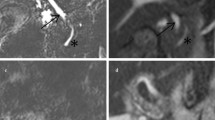Abstract
This study compares the quality of technical images in rendering the biliary tree magnetic resonance imaging (MRI) scans based on a three-dimensional (3-D) respiratory-triggered, fast-recovery, rapid spin-echo (3-D RT-FRFSE) technique with that of a 2-D contrast-enhanced breath-holding half-Fourier acquisition single-shot turbo spin-echo (2-D CE-BH-HASTE) technique. The MRI equipment used in this study was a 1.5 T unit (General Electric medical system, excite HD). A total of 30 patients (15 males and 15 females, mean age of 45 years) were examined. A 2-D CE-BH-HASTE technique was used to perform the scan using an interleaved acquisition at a small thickness within 15 s after injecting the contrast medium. The 3-D RT-FRFSE technique is referred to as a respiratory-triggered technique, where the scan is performed in a respiratory-triggered setting so that patients and MRI equipment can synchronize with the respiration. On quantitative analysis, the signal-to-noise ratio was obtained using the biliary tree and background noise, and the absolute contrast-to-noise ratio was obtained using the difference between the biliary tree and its adjacent tissue. On qualitative analysis, two radiologists and three experienced radiological technicians made an assessment based on the anatomic delineation, visibility of eight biliary trees and degree of image artifacts. The difference in image quality between the two techniques was assessed using a paired t-test and Wilcoxon signed-rank test. After quantitative analysis, the signal-to-noise and contrast-to-noise ratios for the common bile duct, common hepatic duct, intrahepatic bile duct, bile duct and pancreatic duct were found to be higher with the 3-D RT-FRFSE technique than with the 2-D CE-BH-HASTE technique. However, the excellent degree of the 3-D RT-FRFSE technique for the common bile duct, bile duct and pancreatic duct solely was significant (p < 0.05). The common hepatic duct showed an equivalent profile in the two techniques (p = 0.041). In addition, the 2-D CE-BH-HASTE technique showed a significant difference for the intrahepatic duct (p < 0.05). On qualitative analysis, the 3-D RT-FRFSE technique produced significant results with the delineation of eight biliary trees as well as anatomical delineation (p = 0.014, 0.039). However, there were no significant results regarding the artifacts of the images (p = 0.808). In conclusion, from the aspects of the quality of technical images, the 3-D RT-FRFSE technique can render the overall shape of biliary tree using a single test compared with the 2-D CE-BH-HASTE technique. However, the concomitant use of the two techniques would be useful for obtaining optimal information on the biliary tree.





Similar content being viewed by others
References
J.H. Cho, H.J. Kwon, S.K. Yoon, J.H. Lee, M.J. Kang, J.Y. Oh, S.W. Lee, M.H. Noh, K.J. Nam, Korean J. Radiol. Soc. 59, 29–35 (2008)
J.Y. Choi, J.M. Lee, J.Y. Lee, S.H. Kim, M.W. Lee, J.K. Han, B.I. Choi, J. Magn. Reson. Imaging 27, 94–101 (2008)
D.V. Sahani, R. Kadavigere, M. Blake, C. Fernandez-del Castillo, G.Y. Lauwers, P.F. Hahn, Radiology 238, 560–569 (2006)
A.S. Fulcher, M.A. Turner, G.W. Capps, A.M. Zfass, K.M. Baker, Radiology 207, 21–32 (1998)
K.R. Nandalur, H.K. Hussain, W.J. Weadock, E.J. Wamsteker, T.D. Johnson, A.S. Khan, A.R. D’Amico, M.K. Ford, S.R. Nandalur, T.L. Chenevert, Radiology 249, 883–890 (2008)
C.C. Nolte-Ernsting, A. Bücker, G.B. Adam, J.M. Neuerburg, P. Jung, D.W. Hunter, G. Jakse, R.W. Günther, Radiology 209, 147–157 (1998)
M.S. Park, T.K. Kim, K.W. Kim, S.W. Park, J.K. Lee, J.S. Kim, J.H. Lee, K.A. Kim, A.Y. Kim, P.N. Kim, Radiology 233, 234–240 (2004)
G. Reuther, B. Kiefer, A. Tuchmann, F.X. Pesendorfer, Am. J. Roentgenol. 168, 453–459 (1997)
S.M. Shin, S. Kim, J.W. Lee, C.W. Kim, T.H. Lee, S.H. Lee, G.H. Kim, Am. J. Roentgenol. 188, 341–347 (2005)
A. Sodickson, K.J. Mortele, M.A. Barish, K.H. Zou, S. Thibodeau, C.M.C. Tempany, Radiology 238, 549–559 (2006)
R. Tamura, T. Ishibashi, S. Takahashi, Radiology 238, 920–928 (2006)
Y. Tang, Y. Yamashita, A. Arakawa, T. Namimoto, K. Mitsuzaki, Y. Abe, K. Katahira, M. Takahashi, Radiology 215, 81–88 (2000)
P.A. Wielopolski, J. Gaa, D.R. Wielopolski, M. Oudkerk, Radiology 210, 247–252 (1999)
Y. Yamashita, Y. Abe, Y. Tang, J. Urata, S. Sumi, M. Takahashi, Am. J. Roentgenol. 168, 1449–1454 (1997)
Author information
Authors and Affiliations
Corresponding author
Rights and permissions
About this article
Cite this article
Goo, EH., Kweon, DC., Dong, KR. et al. Comparison of 2-D Breath-Holding Half-Fourier Acquisition Single-Shot Turbo Spin-Echo Technique with Contrast Agents and 3-D Respiratory-Triggered Fast-Recovery Fast Spin-Echo Technique in MR Cholangiopancreatography. Appl Magn Reson 40, 177–188 (2011). https://doi.org/10.1007/s00723-010-0192-2
Received:
Revised:
Published:
Issue Date:
DOI: https://doi.org/10.1007/s00723-010-0192-2




